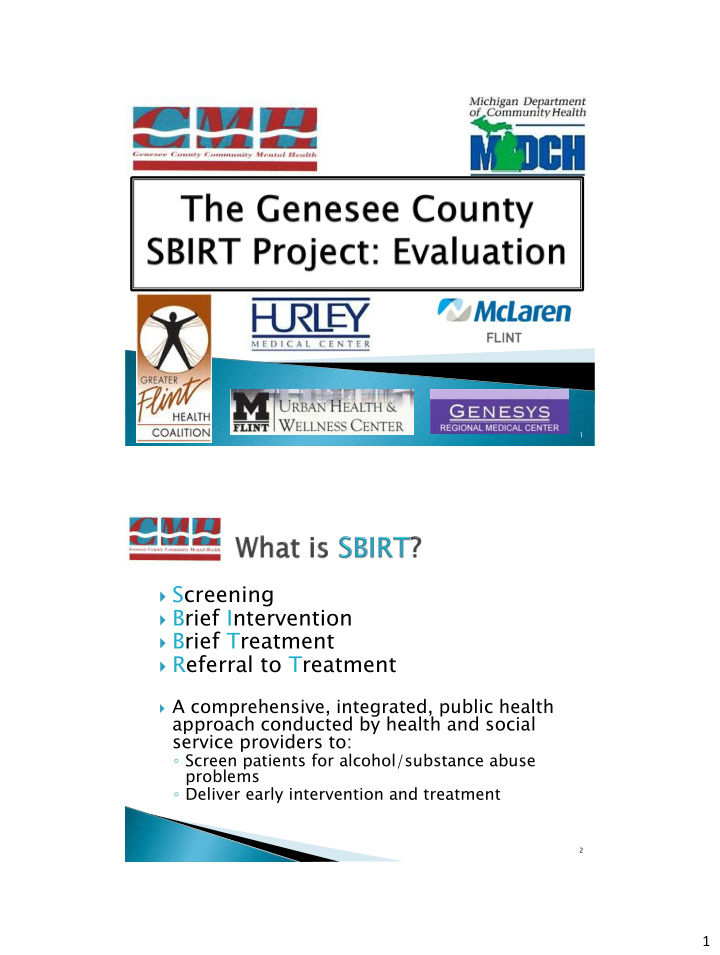



1 Screening Brief Intervention Brief Treatment Referral to Treatment A comprehensive, integrated, public health approach conducted by health and social service providers to: ◦ Screen patients for alcohol/substance abuse problems ◦ Deliver early intervention and treatment 2 1
Clinics: Contact/Physicians: 2 Family Medicine McLar aren en: : Ken Deight hton n & Dr. . Bar arba bara a Wolf clinics Genesys sys: : Dr. . Mark Vogel Hurl urley ey: : Dr. Vicki ckie e Mello & 1 OB/GYN clinic Renay nay Gaglea eard Urban Health & U of M-Flint nt: : Susa san n Wellness Center Schne hneber berger er & S Sandy andy Manssur nssur 3 All patients, age 18 years and older, at the pilot clinics Screen each patient annually Written informed consent will be obtained to include patient data in evaluation ◦ All data will be reported in aggregate form ◦ Patients will be identified by a study identifier number on data collection sheets Six-month follow-up will be sought for every patient receiving brief intervention, brief treatment, or referral to treatment 4 2
+ + + 5 How often do you have a drink containing alcohol? How many drinks containing alcohol do you have on a typical day when you are drinking? Women: How often do you have 4 or more drinks on one occasion? Men: How often do you have 5 or more drinks on one occasion? How many times in the past year have you used a recreational drug? How many times in the past year have you used a prescription medication for nonmedical reasons? How many times in the past year have you used an over-the-counter drug for nonmedical reasons? 6 3
Questions #1-3 are alcohol use (AUDIT-C) ◦ Positive if: ≥3 for women and persons age 65 and older ≥4 for men ◦ If positive, person should complete full screen Questions #4-6 are drug use ◦ Positive if score is >0 (any drug use in past year) ◦ If positive, person should complete full screen 7 AUDIT (alcohol) DAST-10 (drugs) 10 questions, multiple choice 10 questions, Yes/No Each question has 5 answer choices Answers assigned points & totaled Answers assigned points & totaled 8 4
Possible score ranges from 0 to 40 The higher the score, the more likely to indicate hazardous or harmful drinking Zone 1: Low-risk/abstain ◦ Score 0-6/7 Zone II: Risky ◦ Score 7/8-15 Zone III: Harmful ◦ Score 16-19 Zone IV: Dependent ◦ Score ≥20 9 Possible score ranges from 0 to 10 The higher the score, the higher the likelihood of a substance use disorder Zone 1: Low-risk/abstain ◦ Score 0 Zone II: Risky ◦ Score 1-2 Zone III: Harmful ◦ Score 3-5 Zone IV: Dependent ◦ Score ≥6 10 5
Inter terve venti tion on Screening Brief Brief Referral to Measures Collected: ted: only Intervention Treatment Treatment Screening tool scores x x x x Demographics x x x Patient satisfaction with x x x screening/initial visit Service(s) received x x x National outcome x x measures Screening for co- occurring disorders x (ACORN) Six-month follow-up (screening tools, x x x satisfaction, national outcome measures) 11 Clinic location Gender Race/ethnicity Age Insurance status Pregnancy status (for women) 12 6
Housing stability Education level and status Employment status Overall health perspective Social support Criminal justice status 13 Pre- and post-questionnaire on knowledge, attitude, behavior, and satisfaction of SBIRT 6-month and 12-month follow-up Identify additional training needs, barriers, and sustainability efforts 14 7
Importance of screening Identifying patient risk level SBIRT model Brief intervention Motivational interviewing 15 Attitudes around substance use disorders Attitudes around screening patients Readiness to implement SBIRT Post-training: ◦ Attitudes around SBIRT process ◦ Challenges/barriers perceived and/or encountered 16 8
Are they currently: ◦ Screening for alcohol and drug use ◦ Re-screening annually ◦ Providing brief interventions ◦ Using motivational interviewing techniques ◦ Referring for treatment services 17 Training satisfaction ◦ In-person training on SBIRT and Motivational Interviewing ◦ Simmersion training modules (online role playing) Process satisfaction ◦ Screening process ◦ Behavioral health consultant ◦ Referral process ◦ Time required 18 9
Number individuals screened Number individuals that received 1) brief intervention, 2) brief treatment, or 3) referral to treatment Number of sessions each patient completes Number of health care providers trained 19 Decreased AUDIT and DAST-10 score at 6- month follow-up Positive patient satisfaction Increased health care provider knowledge of substance use screening and SBIRT Increased number of health care providers screening patients for substance use and intervening Positive health care provider attitudes around SBIRT 20 10
“SBIRT -- Screening, Brief Intervention and Referral for Treatment -- is a recognized, proven and even reimbursed medical procedure that awaits general use despite the consequences of not using it.” – Dr. Lloyd I. Sederer, MD Medical director, New York State Office of Mental Health 21 11
Recommend
More recommend